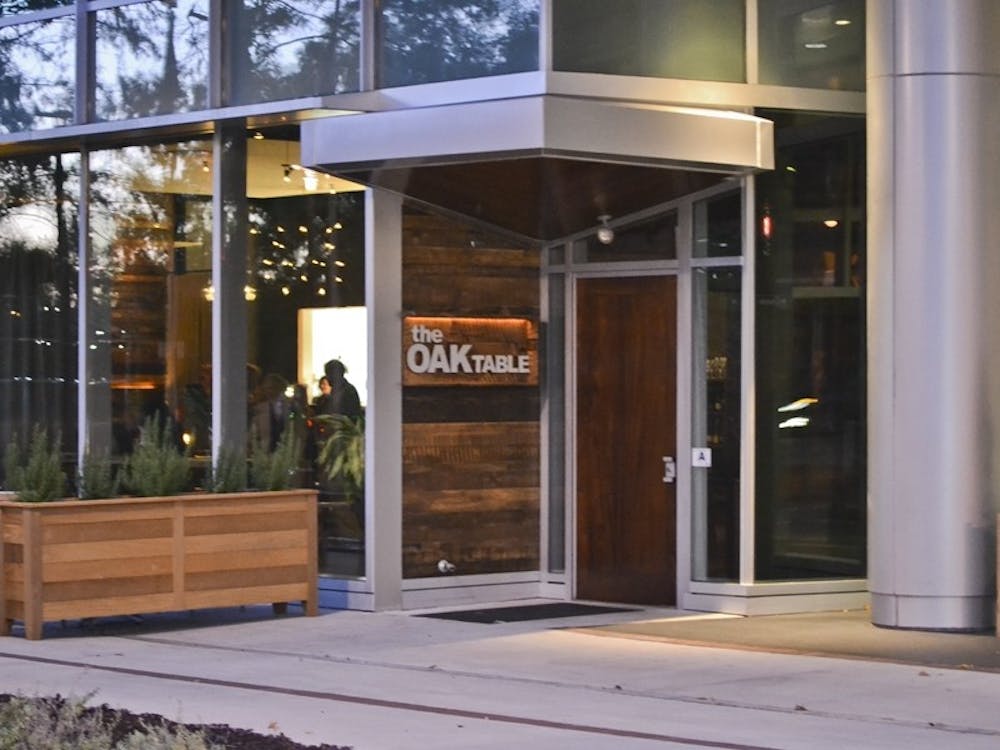Charleston native brings high-end dining, hospitality to Columbia’s Main Street
With his fingers wrapped around a knife, deboning the inside of a whole pig, Joseph Jacobson is in his element.
Inside a University of South Carolina classroom eight years ago, Jacobson felt like he was wasting his time.
The Charleston native has found himself back in Columbia, returning to the city he abandoned in favor of an unconventional road to his dream. As the executive chef of The Oak Table, Jacobson has arrived at the place where it all began.
“I guess from listening to my professor a lot and seeing what he was teaching us, I decided that I have this great restaurant opening around the corner from me in Charleston, so it would probably make sense for me to try and work there,” said Jacobson, a hospitality management student at the time.
Jacobson went home for winter break and didn’t return to USC. He started as the server’s assistant at Oak Steakhouse in Charleston, and within a week, he became the full-time expediter.
When the restaurant was busy, Jacobson would take the opportunity to help in the kitchen, working his way into a full-time job as the chef de cuisine. After Oak Steakhouse became a part of the Indigo Road Restaurant Group, which continued to expand throughout Charleston, “the next logical place was Columbia,” he said.
“They offered for me to move up here,” Jacobson said. “I came and saw the space and fell in love. I thought it was awesome.”
Located on the corner Gervais and Main streets, looking on to the Statehouse, The Oak Table uses as much homegrown produce as it can to offer a unique menu. With a business crowd primarily taking in the 11 a.m. to 10 p.m. weekday hours, Jacobson’s menu offers something for every taste, ranging from the Butcher Board sandwich with chicken liver pate for lunch to a traditional hanger steak for dinner.
For those squeamish about chicken liver, the lunch menu offers a twist on a BLT, with pimento cheese and served on a brioche bun. The fried lobster roll is also a popular choice, served with truffled pomme frites that are addictive and delicious without condiments.
With lunch items ranging anywhere from $7 for a simple salad to $19 for pan-seared scallops, Jacobson also offers small plates like duck confit fritters, beef carpaccio and made-in-house charcuterie that customers can order to try a variety of food for the cost of one entrée.
One of the chef’s favorites is a small plate on the dinner menu — the lobster with ricotta gnudi, house-made ricotta dumplings with lobster, cherry tomatoes and roasted Tennessee oyster mushrooms.
“Coming into a new market, what we didn’t want to do was scare people with sticker shock,” Jacobson said. “We weren’t going to come into the market with $100 steaks. We ate at some of the local restaurants around town and came up with a price point we thought would be the most fitting for the area.”
The menu, printed and placed on a small oak clipboard, changes every day so Jacobson can offer fresh options. He said he only brings in whole fish because it displays all of the indicators of how the fish has been treated, showing if it’s fresh or not. Jacobson said he likes to serve only fish that’s been out of the water for an entire day.
One of Jacobson’s initial worries about leaving Charleston was leaving behind a lot of local farms, but he said he’s realized Columbia has a lot more local produce available because the culinary scene isn’t as saturated.
Cutting off the legs and taking the meat off a whole pig, Jacobson mentions the pig is also local, hailing from Pamplico, S.C. The meat he’s cutting off will be ground into a sausage later that day before being stuffed back into the pig and roasted whole so the skin is crispy. A cross section of the roasted skin with the sausage in the middle is an Italian dish called porchetta.
His effortless handling of the pork is ironic, as Jacobson’s love for cooking stemmed from his Jewish family gatherings in Charleston, often having oyster roasts together. He learned by watching his grandmother cook every Friday night for the family.
An executive chef at just 27, Jacobson’s never had any formal cooking training, learning on the job from working with other chefs. He said becoming an executive chef before the age of 30, as well as attaining that title without attending cooking school, is becoming more common.
“A lot of times I have kids who have been in culinary school and they’ve never worked in a restaurant before, but they’ve just graduated school and say, ‘Oh, I’m a chef,’” Jacobson said. “Well, a lot of times it’s a rude awakening for them when they take their degree and they get in the real world and see that it’s a little bit different than what the textbook tells you.”

